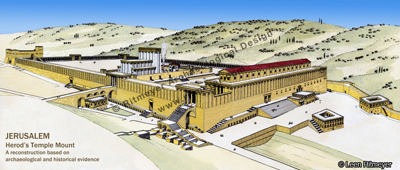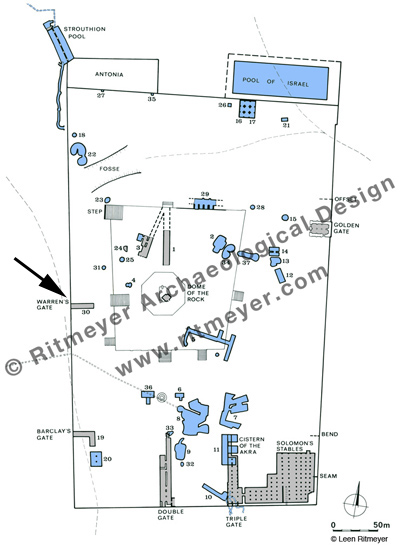In today’s Makor Rishon (Hebrew) newspaper, Arnon Segal published an article, called Otiot porchot be-avir (letters blossom in the air). Based on the diary of the Rabbi of the Western Wall, Rabbi Meir Yehuda Getz, he retells the story of the underground excavations and the struggle that took place inside Warren’s Gate in 1981. Warren’s Gate is the northern-most of the four original Herodian gateways that gave access to the Temple Mount through the Western Wall.

Herod the Great enlarged the existing Temple Mount to double its size and built a new Temple. In the Western Wall (left) there were four gates. Warren’s Gate is the northern-most gate in the Western Wall (on the left). The Southern Wall (right) had two gates. Above this wall stood the Royal Stoa. The Antonia Fortress at the northwest corner (far left) guarded the Temple Mount from the north.
In April 1866, Captain Charles Wilson inspected this underground passageway which for several centuries had been used as a water reservoir. Three years later, Charles Warren examined the cistern (Cistern 30, see below) and noted that its western end pierced the Western Wall. It measures 25.6×5.50m and its floor is 10.50m below the level of the Temple Mount. This cistern was originally a Herodian underground passage, leading up from Warren’s Gate to the Temple Mount, possibly having an internal L-shaped stairway like at Barclay’s Gate. A relatively modern stairway descends from the west into the cistern. Wilson later named this gate after Warren.

Some of the water cisterns, such as Cisterns 7 and 8 were enormous underground water reservoirs, capable of holding some 2 million gallons of water. Most of these cisterns were initially underground quarries from which building stones for the buildings of the Temple Mount were taken. After the quarrying activities were stopped, these caverns were plastered and became water reservoirs.
This underground tunnel was accidentally rediscovered in 1981 during excavations that took place along the Western Wall north of Wilson’s Arch. During the construction of an underground synagogue, workers broke through the wall that had blocked up the gate opening.
Rabbi Getz believed that this gate was used in the past by priests going up to the Temple. He also believed that this passage led to the lost Temple treasures and to the Ark of the Covenant. After working in secret for about a month, Arabs found out from a media report that the Israelis were excavating below the Temple Mount. They descended into the cistern through two manholes from above and closed off the gate with a very thick concrete wall.
The dream of Getz to reach the Temple Treasures, especially the Ark of the Covenant, was dashed. According to his diary, he sat down with ashes on his forehead, praying: “O God, the nations have come into your inheritance; they have defiled your holy Temple.” (Psa. 79:1).
Despite the fact that this excavation was illegal, it nevertheless would have been exciting to find out more about how exactly this underground passage originally worked.
HT: Yisrael Medad

Yaakov,
You should read my book The Quest, as that will answer most of your questions.
Dear Dr.Ritmeyer. I just received your book “the quest”. It’s very informative and a must have regarding the temple topic!
Regarding the “Getz affair” I found a picture in the net
http://up.picr.de/23501608up.jpg
claiming a vault under the Dome of the Rocks and a tunnel leading to it from the Warren Gate. Moreover there is a picture which shows supposedly this tunnel during the Getz activity.
I have my doubts. If the Israeli authorities really have indication that the arc is present who the hell would leave the most important artefact of the worlds history to muslim vandalism? They have their own possibilities to climb in from the platform above. What would they do..to save it? For sure nothing. The would secretly destroy it in order to hit the jews right into the heart! So an existing vault (maybe under the well of souls) must have initiate a massive struggle of Israel to save the ark. But nothing happened.
Well just my humble opinion
cheers
Ben,
You are right – this is totally misleading. First of all, the original diagram is mine, which I feel has been desecrated by the nonsense outline of a non-existing tunnel. The picture of the tunnel, by the way, was taken inside the Herodian drain that runs below Robinson’s Arch outside the Temple Mount.
this articel includes an interesting picture – someone have changed the carpets in the “well of Souls”
http://www.dailymail.co.uk/news/article-3048270/Replacing-carpet-Jerusalem-shrine-reveals-religious-rift.html
cheers
Dear Prof Ritmeyer!
I found a picture which was made during the process of changing the carpets in the “well of the souls” chamber this spring.
http://up.picr.de/23837910dl.jpg
It unveils two rectangular mosaics which look like hatches for some underground caves.
Do you know who has made these mosaics and for what purpose?
Thanks for an occasionally response
Cheers from Ben
Just wondering – does Getz’s diary mention the rabbinic legends in Mishna Shekalim, chapter 6? Or similar talmudic texts?